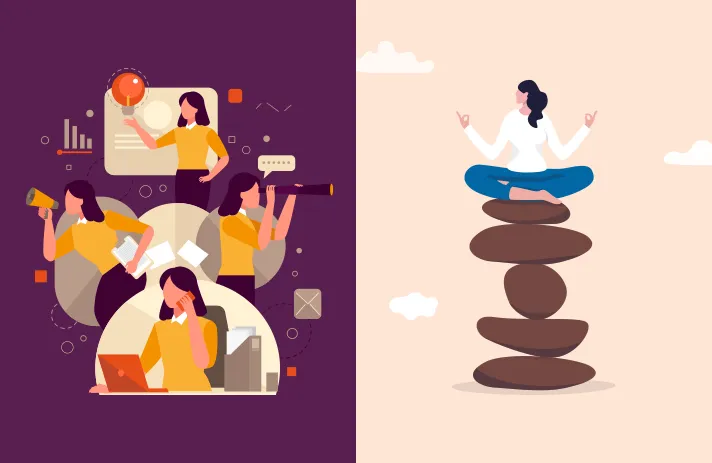In today’s fast-paced world, multitasking has become almost a badge of honor. Between work emails, household chores, family responsibilities, and personal projects, many of us are constantly juggling multiple tasks at once. Yet, research consistently shows that conventional multitasking often reduces productivity, increases stress, and diminishes focus.
However, there is a way to balance multiple responsibilities without sacrificing your presence or mental well-being: mindful multitasking. By integrating mindfulness into our daily routines, we can approach each task with intention, reduce mental fatigue, and achieve more meaningful results.
This article explores the concept of mindful multitasking, the science behind it, practical strategies to implement it, and the benefits it brings to productivity, mental health, and overall quality of life.
Table of contents
- Understanding Mindful Multitasking
- The Science Behind Mindful Multitasking
- Signs You Need Mindful Multitasking
- Principles of Mindful Multitasking
- Practical Strategies for Mindful Multitasking
- Common Mistakes to Avoid
- Benefits of Mindful Multitasking
- Real-Life Examples
- Tips to Get Started with Mindful Multitasking
- Mindful Multitasking in the Workplace
- Mindful Multitasking and Personal Growth
- Conclusion
Understanding Mindful Multitasking
At first glance, “mindful multitasking” may seem contradictory. Mindfulness emphasizes present-moment awareness and focused attention, while multitasking is traditionally associated with dividing attention across multiple activities.
Mindful multitasking is not about doing everything at once blindly. Instead, it involves:
- Being aware of what you’re doing in each moment.
- Approaching each task with intention.
- Minimizing mental distractions and unnecessary stress.
- Prioritizing tasks effectively to optimize flow and efficiency.
Essentially, it is multitasking with awareness, blending productivity with presence.
The Science Behind Mindful Multitasking
1. Cognitive Load and Focus
Our brains are not designed to handle multiple high-focus tasks simultaneously. Conventional multitasking often leads to “attention residue,” where the mind lingers on the previous task while trying to focus on the current one. This can reduce efficiency by up to 40%, according to research.
Mindful multitasking, however, encourages task segmentation and presence, helping the brain handle each component without mental overload.
2. Stress Reduction
Mindfulness practices are known to reduce cortisol, the stress hormone. By applying mindfulness while switching between tasks or handling multiple responsibilities, we can mitigate stress responses and maintain emotional equilibrium.
3. Enhanced Productivity
Studies suggest that when attention is deliberately directed toward each task—even if switching frequently—people make fewer mistakes, retain more information, and complete work faster. Mindful multitasking improves quality over mere quantity, allowing you to accomplish more with less mental fatigue.
Signs You Need Mindful Multitasking
Many people feel overwhelmed without realizing it. Some indicators that mindful multitasking could benefit you include:

- Frequent distractions or difficulty focusing.
- Constant mental fatigue despite finishing tasks.
- Procrastination on important responsibilities.
- Anxiety or stress related to your to-do list.
- Feeling guilty or unsatisfied despite being busy.
Recognizing these signs is the first step toward a more balanced and productive approach to multitasking.
Principles of Mindful Multitasking
Implementing mindful multitasking requires adopting certain principles:
1. Intentionality
Before starting any task, ask yourself:
- “Why am I doing this?”
- “What is the desired outcome?”
Setting clear intentions ensures you engage fully with each task rather than drifting aimlessly.
2. Task Prioritization
Not all tasks hold equal weight. Mindful multitasking involves strategically identifying high-priority tasks and combining them only with compatible, low-stress activities. For example, listening to an educational podcast while commuting may be more suitable than responding to critical emails.
3. Sensory Awareness
Focus on the physical and mental experience of the task. Notice sounds, textures, movements, or thoughts associated with each activity. Sensory engagement anchors you to the present moment and reduces mental drift.
4. Single-Task Mindfulness Within Multitasking
Even when handling multiple responsibilities, you can approach one aspect at a time with full attention. For instance:
- Cooking while supervising children: Focus on chopping vegetables fully before attending to your child’s needs.
- Answering emails while on hold: Concentrate on drafting a clear response before switching back to the call.
5. Scheduled Task Switching
Plan specific intervals for alternating between tasks rather than switching randomly. This reduces mental strain and allows the brain to reset between activities.
Practical Strategies for Mindful Multitasking
1. Combine Complementary Tasks
Pair tasks that don’t compete for the same cognitive resources. Examples:
- Walking while listening to an audiobook.
- Folding laundry while practicing deep breathing or gratitude.
- Watering plants while brainstorming ideas mentally.
The goal is to maintain presence in both tasks without compromising safety or quality.
2. Use Mindful Pauses
Between task switches, take short pauses to re-center attention. A deep breath, body scan, or two-minute stretch can help reset focus and reduce stress.
3. Digital Mindfulness
Technology is both a boon and a distraction. Mindful multitasking with digital devices involves:
- Turning off unnecessary notifications.
- Using focus apps to manage time.
- Engaging fully with one platform at a time.
For example, replying to emails in scheduled blocks rather than sporadically can increase efficiency.
4. Practice Mindful Listening
When interacting with colleagues, friends, or family while engaged in other tasks, actively listen rather than simply hearing words. This strengthens relationships and reduces the cognitive overload of divided attention.
5. Time-Boxing Tasks
Assign specific time limits for tasks. For instance, dedicate 25 minutes to focused work (Pomodoro technique) and then switch tasks intentionally. This prevents prolonged attention residue and encourages mindful transitions.
6. Integrate Mindfulness Exercises
Incorporate short mindfulness practices into your multitasking routine:
- Breath awareness while commuting.
- Observing posture and muscle tension while working at a desk.
- Mindful eating during quick meals.
Even small practices enhance presence and cognitive clarity.
Common Mistakes to Avoid
Even with mindfulness in mind, some pitfalls can reduce the effectiveness of multitasking:
- Overloading: Trying to juggle too many high-focus tasks simultaneously.
- Mindless Switching: Constantly shifting attention without intention.
- Neglecting Self-Care: Skipping breaks, food, or hydration.
- Ignoring Task Compatibility: Combining tasks that compete for the same cognitive resources.
Awareness of these mistakes allows you to refine your approach for better outcomes.
Benefits of Mindful Multitasking

1. Increased Productivity
By reducing distractions and focusing on intention, mindful multitasking enables faster, higher-quality output. You achieve more without the typical mental drain of traditional multitasking.
2. Reduced Stress
Mindful approaches cultivate calm and emotional resilience. Stress is no longer compounded by constant task-switching or guilt over incomplete work.
3. Improved Mental Clarity
When attention is managed mindfully, mental fog decreases. Your brain retains information more effectively, and decision-making improves.
4. Enhanced Emotional Awareness
Mindful multitasking nurtures emotional intelligence. You become more attuned to internal cues and can respond thoughtfully rather than react impulsively.
5. Better Work-Life Balance
By integrating mindfulness into productivity, you can accomplish tasks efficiently while staying present for yourself and others, creating a healthier balance between professional and personal life.
Real-Life Examples
Example 1: Remote Work
Maria, a remote worker, practices mindful multitasking by checking emails in scheduled intervals while taking short mindful breaks to stretch and breathe. She pairs repetitive tasks like filing digital documents with a favorite podcast, maintaining presence without mental fatigue.
Example 2: Parenting
David balances household chores with childcare by engaging fully in each moment. While helping his child with homework, he puts aside other distractions. During downtime, he uses chores like folding laundry as mindful reflection time.
Example 3: Fitness and Learning
Sophie listens to educational podcasts while running or cycling. She focuses on her breath and form while absorbing new information, demonstrating a harmonious balance between physical and mental engagement.
Tips to Get Started with Mindful Multitasking
- Start small: Combine simple, compatible tasks.
- Schedule intentional transitions between tasks.
- Set clear goals for each activity.
- Use sensory awareness to remain anchored in the present.
- Practice short mindfulness exercises daily.
- Avoid distractions from social media and notifications.
- Reflect at the end of the day on what worked and what didn’t.
- Celebrate small wins to reinforce positive habits.
- Use reminders or apps to cue mindfulness during routine tasks.
- Stay patient—mindful multitasking is a skill that develops gradually.
Mindful Multitasking in the Workplace
Organizations can encourage mindful multitasking through:
- Flexible schedules that allow focused work blocks.
- Mindfulness or meditation workshops.
- Encouraging task batching and intentional breaks.
- Reducing unnecessary meetings and digital clutter.
Employees practicing mindful multitasking report higher productivity, lower stress, and better engagement.
Mindful Multitasking and Personal Growth
Beyond productivity, mindful multitasking promotes personal growth by fostering:
- Self-awareness: Understanding your limits and mental patterns.
- Resilience: Handling stress and challenges calmly.
- Presence: Appreciating life’s moments rather than being perpetually distracted.
- Intentionality: Making conscious choices rather than reactive decisions.
Ultimately, mindful multitasking aligns efficiency with well-being, helping individuals lead more balanced, fulfilling lives.
Conclusion
Mindful multitasking is more than a productivity hack; it is a philosophy that blends efficiency with presence. By applying mindfulness principles to daily routines, we can navigate multiple responsibilities without losing focus, increasing stress, or compromising our mental health.
Incorporating intentionality, sensory awareness, task prioritization, and mindful transitions allows us to achieve more while remaining fully engaged in each moment. Whether at work, home, or during personal projects, mindful multitasking empowers us to balance life’s demands while cultivating clarity, calm, and satisfaction.
Rather than trying to do everything at once in a flurry of distraction, mindful multitasking invites us to work smarter, live consciously, and embrace the present—even amid the hustle of daily life.
